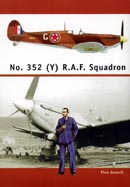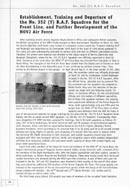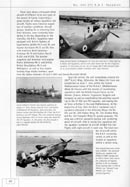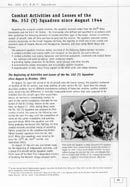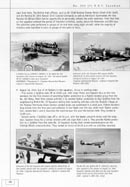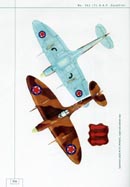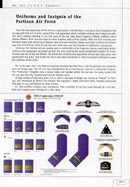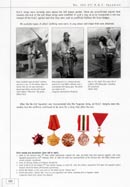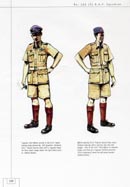|
| NOVJ |
No. 352 (Y) R.A.F. Squadron
mr.sc. Tino Jelavić dipl.ing.aeronautike-pilot
FOREWORD
At the Teheran Conference,
November 28 to December 1, 1943, the USA joined the UK and USSR in
recognizing the Narodno Oslobodilačka Vojska Jugoslavije -
NOVJ as an equal member of the anti-Axis
coalition. The Allies decided to offer NOVJ
military as well as humanitary aid, by providing for the wounded and
for the large-scale exodus of the civilian population from the
Dalmatian coastal area. The United Kingdom was, geographically, the
nearest of the three forces and also the first Allied power with the
most detailed knowledge of the actual events in the former Kingdom of
Yugoslavia. It was aware of NOVJ being the only
force in the
country that was really fighting the Axis. Most of the merit for what
happened in Teheran is due to Sir Winston Churchill. Even before the
conference, leaving political considerations aside, the great man
decided to support militarily all forces fighting the Germans. He knew
with certainity about what force there where in Yugoslavia. The man in
his personal confidence Brigadier (later Sir) Fitzroy MacLean (with
previous commando experience in Iran and North Africa), sat near the Vrhovni
štab (SHQ) NOVJ
and was a key man in the negotiation of the United Kingdom's military
aid to NOVJ. That aid included the formation of Air
Force units to meet NOVJs needs.
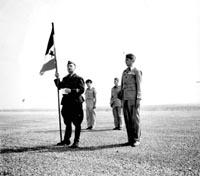
Pukovnik
France
Pirc in front of No. 352 Sqd during their oath on April 22, 1944 Baninah
Mario
Šoić |
All the
pilots, observers, mechanics and other aeroplane experts were withdrawn
from NOVJ units and assembled at the Air base of
the Glavni štab Hrvatske
(GHQ of Croatia) on Krbavsko polje, near Udbina, and at the SHQ Air
base at Livno. A large number of pilots and other air personnel
deserted the NDH AF and joined the NOVJ.
All of them
reached Italy via Vis island, being initially at a base near Bari. The
group grew in number due to the influx of Istrian Slovenes, themselves
former Italian military captured by the British. The airmen then sailed
from Italy to Alexandria, transferring to Benghazi, before being based
on the Beninah desert airfield in the vicinity of the town. Here the
group increased it's size considerably after being joined by 2nd
(Yugoslav) Squadron personnel, as well as some USAAF airmen of Yugoslav
descent. In the event, there were more pilots and other staff than
where needed to man the two initial squadrons that the R.A.F. was to
provide.
The training of pilots and technical personnel for
two squadrons, No 352 (Fighter-Bomber) with Spitfire
Mk V C and No 351 (Fighter-Bomber) with Hurricane
Mk IV RP (Rocket Projectile), began immediately. The crews had a full
R.A.F. training. The pilots began training with the Harvard
Mk II B, advancing to the Hurricane Mk II C, with
No 352 Sqn. pilots continuing on the Spitfire
Mk V C. No 352 Squadron pilots main training was in air fighting,
ground attack being considered of secondary importance. The armament of
a Spitfire Mk V C consisted of four .303 (7,7 mm)
machine guns and two 20 mm cannons, with provision for two 250 lb (113
kg) bombs. The Spitfire (of any variant) was a
"royal falcon" for air combat, but no more than a very vulnerable "hen"
in the ground-strafing role. Hurricane
Mk IV RP was vice versa - easy prey for any modern fighter, but, due to
its eight 11,3 kg or 27,2 kg rockets, a proper "hawk" for ground
attack. Furthermore, Hurricane could dodge Flak the
moment it released its rockets, whilst the Spitfire
had to fly right over the target to release it's bombs.
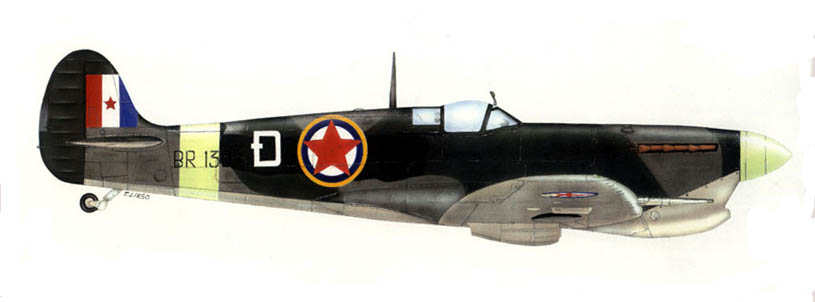
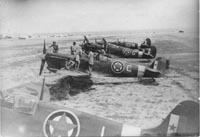
Spitfires
before first mission on August 18, 1944, from airport Canne - Italy
Yugoslav
Aeronautical Museum |
This
book describes the hard warpath of No 352 (Y) Squadron R.A.F. Suffice
it to say that the unit lost its Squadron Leader, four Flight
Lieutenants and almost a third of its pilots in a very short time.
These losses were much above the R.A.F. or B.A.F. average and some
words of explanation might be in order for a reader of today. No 352
was basically a fighter squadron, its training concentrated on air
combat. Ground attack was of secondary importance, for the Spitfire
was not well suited in that role. Unfortunately for its pilots, the
time of "dogfighting" was over. German fighter pilots were far from
being cowards, but they were ordered to avoid a dogfight and to attack
transport aircraft and, if possible, unescorted bombers. In an attempt
to escape, a Henschel "recce" aircraft, that the No 352 Squadron pilots
happened to spot and strafe, hit a hillside and burned. In another case
a Focke Wulf FW 190, in the Metlika area, dived immediately, and all
that No 352's pilots were able to do was to send a farewell burst after
it, the German fighter outdiving the Spitfire every
time.
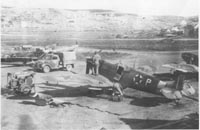
Work
on Spitfire with unusual combination of NOVJ
insignia and UK flag on tail, winter 1944/45 Vis airport.
Josip
Novak |
In the event, it happened
that the Spitfires had a period of very intensive
ground attack missions before the Hurricanes
became operational. The most difficult task was strafing retreating
German columns in the hills, where they could only be hit from a
particular direction. The only way to score a hit with bombs or gunfire
was to enter the zone of fire of the very efficient German AAA. German
20 mm four-barrelled guns with experienced crews were very dangerous.
Their only weak spot was that they were towed rather than being mounted
on a vehicle. One or at the most two attacks were possible before the
Flak got into action. The third and subsequent attacks were extremely
risky and this explains the unusually high losses of No 352 Squadron.
Under such circumstances, a British or Australian Flight of four Spitfires
would, for example, strafe a column once and in rare cases twice. If
that resulted in six or seven out of ten German trucks aflame, and
three or four intact, the pilots would say "Goodbye, see you
next day".
They knew that the third and fourth run would be extremely dangerous,
for unless the Flak was destroyed, they would meet with very accurate
fire.
Unlike
that, our pilots would not be satisfied with four trucks missed, and
they would press home the third and fourth run, until all the trucks
were burning. At the same time the Flak fire would get very accurate.
This example is but an illustration why their losses were high. Today,
one might raise the question of our pilots training, and ask were they
aware of the danger at all. They did ask, they were aware, and they
deliberately faced the danger. They set their own code and rules of
behaviour. A lot was expected of them, and they strived to achieve more
than the Spitfire was fit for in such a unsuitable
role. With the arrival of the Hurricanes,
with their eight rockets, attacks upon German columns became much more
successful. Most important of all, the moment it released its rockets,
the Hurricane was free to manouvre instantly to
avoid Flak fire. At that time Spitfires flew as
cover for the Hurricanes, or attacked other
targets, and their losses dropped markedly.
Technical
and other services, with their round-the-clock duty posts, also did
their share in enabling No 352 Squadron to complete so many combat
flights. Wheels and tyres were all too easily damaged on tarmac-covered
airfields, if they came too close to the edge of the runway. The
aircraft very often got damaged in combat and had to be repaired and
maintained regularly. Despite all the problems, the number of
serviceable aircraft was high at all times. It is of interest that 75%
of the personnel of the R.A.F's first NOVJ unit's,
No 352 (Y)
Fighter-Bomber Squadron, were Croats and coastal Slovenes. This is
today, of course, merely statistical data of history. That said, all
the pilots demonstrated impressive courage in battle, while all other
staff did their duties with great dedication.
General-pukovnik
(ret.)
Zlatko Rendulić Ph.D. .
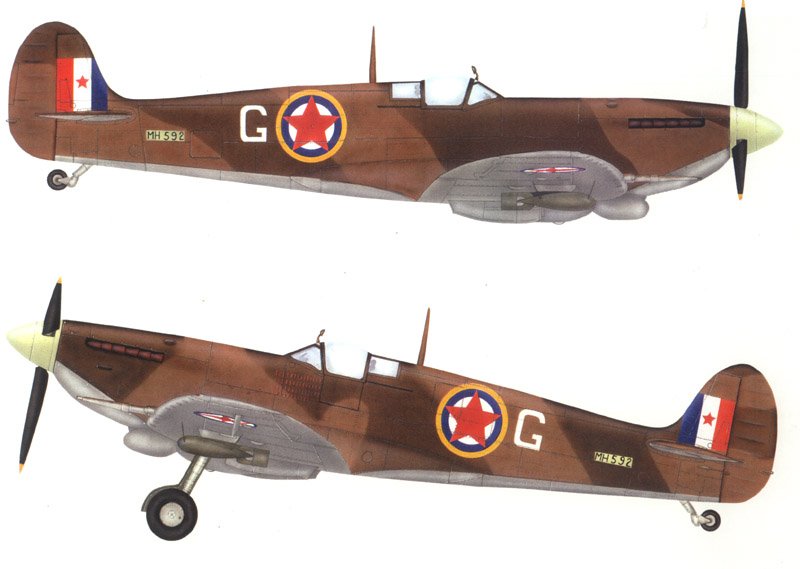
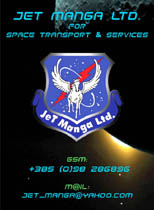 |
Knjiga je tiskana na engleskom, a po
potrebi dostavlja se sa prijevodom. Za detaljnije informacije o ovoj knjizi kao i načinu njene nabave možete direktno kontaktirati izdavača na e-m@il: jet_manga@yahoo.com ili
mobitel: +385(0)98
286896
For details about book and orders you may directly contact the publisher on previous e-m@il or gsm. Book is written in English on 168 pages and very rich illustrated (187 photographs and 20 colour pages with aircraft profiles and uniforms/insignia). Book price is 26,55 EUR (29 U$D).
Book
review is also avaliable at - http://stonebooks.com/archives/040208.shtml#c
|
Book
also can be bought or ordered via following bookshops & people:
012
STATION, Svetice 24, 10000 Zagreb, Croatia - jet_manga@yahoo.com
The Aviation Bookshop, 656
Holloway Road, London N19 3PD, United Kingdom - info@aviation-bookshop.com
Hyland's Bookshop, Melbourne,
Australia - hylandsbookshop@hotkey.net.au
Luchtvaart Hobby Shop, Molenweg
249, 1436 BV Aalsmeerderbrug, Nederland - erwin.j.w.stam@planet.nl
Fa.Sound, Postfach 1716, 85317
Freising, Germany - sound.buecher@t-online.de
Nick Konatich, United States of America - nkonatich@hotmail.com
Aleš
Peršin, Grosuplje, Slovenija - kavsek.persin@volja.net
Antonio
Prlenda, Sarajevo, Bosnia&Herzegovina - prlenda@yahoo.com
Pilot Shop - MJV, P.F. 19, 11180
Aerodrom Beograd, Serbia - vladauk@skyinfo.net
Selected pages:
|
|
|
|







